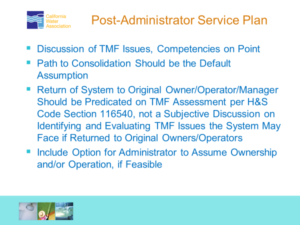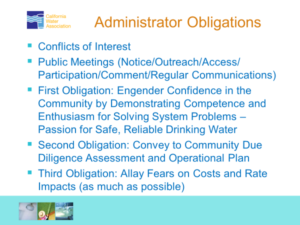California Water Association Executive Director Jack Hawks provided recommendations on California’s new water utility “Administrator” program at an August 21 workshop hosted by staff for the members of the State Water Resources Control Board (State Water Board). Hawks’ principal recommendation was a change in the Post-Administrator Service Plan, which the Administrator is obligated to file with the State Water Board within 12 months of initial contract operations. Specifically, when the State Water Board implements the 2018 and 2019 laws (AB 2501 and SB 200) by contracting with system Administrators for designated public water systems that have demonstrated difficulty in maintaining the necessary technical, managerial, and financial (TMF) capacity to provide an adequate supply of affordable safe drinking water, Board should allow for a path to consolidation with a water utility (not necessarily the Administrator) that has the required TMF expertise to sustain successful operations as the default assumption.
Only when a consolidation is not feasible should the State Water Board consider a return of the system to the original owner/operator, and even then, the return should be predicated on the same TMF assessment required of new or newly acquired systems pursuant the requirements in Health and Safety Code Section 116540. Hawks also pointed out that while attention to potential conflicts of interest and public outreach procedures are critical obligations of the Administrator, the most important obligations are to:
- Engender confidence in the community by demonstrating competence and enthusiasm for solving the community’s drinking water problems…in other words, convey a passion for safe, reliable drinking water.
- Fully explain the problems with the system to the customers and the operational plan designed to solve those problems.
- Allay customer fears on costs and rate impacts as much as possible.
Joining Hawks on the panel were Russ Bryden of the Los Angeles County Department of Public Works, John Allen of the Water Replenishment District of Southern California, Katie Porter of the California Urban Water Agencies, Michael Claiborne of the Leadership Council for Justice and Accountability, and Isabel Solorio from the community of Lanare.
As the first Administrator assigned by the state, Bryden explained in detail what it has taken to solve the former Sativa Water District’s financial, operational, and water quality problems. He noted that “brown water” was only the tip of the iceberg as far as Sativa’s problems were concerned, and that it has cost the County of Los Angeles more than $8 million to date to return the system to solvency and reasonable operations. He emphasized that it takes a team to fulfill the Administrator role, and one person cannot do it alone.







